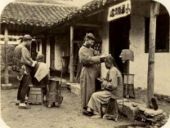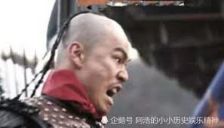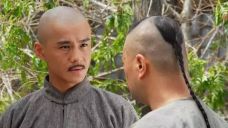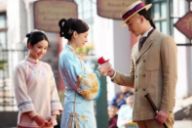Styles of shave and braids
To the European in China, the care bestowed on their long hair by Chinese men is one of the most curious of sights. No hair-brushes are used, but the hair is well combed out, as a rule, every day. It is difficult at first to think that these long tresses, three or four feet or more in length, belong to a man. Carefully combed out by himself or the barber, the hair is plaited into a long queue, in the common style of three strands, and eked out in length still further by a piece of cord till it reaches the knees or heels, and swings and sways with every motion of the body.[cf]
Published in 1911, James Dyer Ball had seen queues like the one we see here. The ones he saw were thick, which is typical for the style towards the end of the Qing. Thick or thin, grooming them must have consumed a lot of time, but must also have been a good reason to socialize. Apart from the queue itself, the whole area around the queue had to be kept bald and smooth from the age of twelve to fourteen. For children, as travel writer Ernst von Hesse-Wartegg wrote around 1900:
[h]ere and there, above the ears, on the top of the head, on the neck, individual small tufts of hair are left standing, so that these cute boys look as if nature were to give them braids in six or more places. It is only after the boys have reached the age mentioned that the skull is completely shaved and only the parting hair is left standing.[cf]
The queue became an important part of Qing Chinese society. Having a long, well-maintained queue showed that its wearer was a man of wealth, and the thickness of the queue also showed the wearer was healthy. Barbers would walk through the neighborhoods with their mobile shops, attracting the queue bearers by chiming their percussion irons. The barber would find a place for the customer to sit and start grooming and braiding.[cf]
The type of braid that was introduced at the start of the Qing, during the reign of the Shunzhi emperor (r. 1644-1661) was very slender. It is said that it was called a ‘money rat tail’, also described by the Han Chinese Yao Wenxi in 1645 as a ‘coin-sized rat’s tail’, stressing the fact that the braid was to be so thin that it could fit through the square hole of a Qing cash coin. At the time of the Qianlong emperor (r. 1735-1796), the style of the braid slowly started to change. The braid became thicker and there was more hair on the crown of the head, being roughly the size of the palm of a hand. By the late Qing period, the hair on the scalp of the head also started to cover more and more skin, resembling an oxtail.
As anti-Manchu nationalism rose in the last years of the Qing, the queue became the symbol of Manchu oppression over the Chinese. Resistance to the queue, which was prominent in the 17th century when it was implemented, flared up once again. However, many Han Chinese were very fond of the queue, which can be clearly seen in the quote by American missionary Arthur H. Smith (1845-1932):
The Chinese people are now more proud of their cues than of any other characteristic of their dress, and the rancorous hostility to the edict of the Manchus survives only in the turbans of the natives of the provinces of Canton and Fukien, coverings once adopted to hide the national disgrace.[cf]







